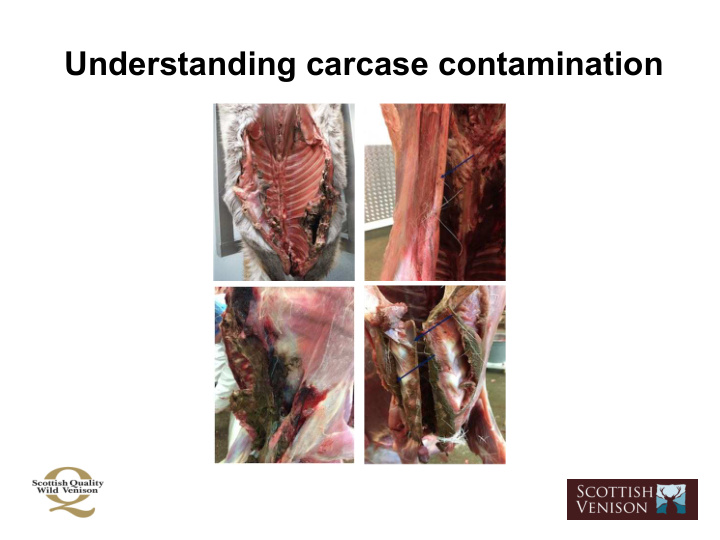



Understanding carcase contamination
Gross or minor contamination? In food production, contamination risk assessment usually covers four types: • Physical • Chemical • Microbiological • Allergenic This presentation concentrates on microbiological contamination – but other forms of contamination cannot be ignored At each stage of the process from shot to sale contamination risk must be considered, assessed and minimised.
Field dressing 3.1.4 Gralloching must be carried out in a hygienic and approved manner, according to Best Practice Guidance and as soon as possible (1 hour maximum) after despatch. Cuts made outside the larder must be minimal. The pluck may be removed from carcase at the time of gralloching. 3.1.5N Carcasses that are grossly contaminated must not be presented for human consumption. Gross contamination – which potentially contains food poisoning bacteria – can occur as a result of gut spill at point of kill or gralloch. The risk is especially heightened with spillage from the rectum, the greatest source of E. coli O157 contamination. Guidance Note E. coli 0157 is most commonly found in the last 20cm of the back passage. Extreme care should be taken to tie off the back passage and consideration should be given to removing this section and the rectum at the larder, or by means of a double cut allowing this section to be carefully lifted backwards from the carcase. At all times great care must be taken to minimise the risk of contamination.
Transfer of carcasses to the larder 3.1.8 Carcasses must be transferred to the larder as soon as possible after despatch and actively chilled to a temperature of 7°C or less within a reasonable period of time after killing and achieve a temperature throughout the meat of not more than 7°C. Note: Active chilling is not required where the climatic conditions are suitable eg when ambient temperature is less than 5 - 7°C. For reporting of the process to be absolutely thorough the actual ambient temperature should be recorded. 3.1.9 Carcasses must not be left outside overnight, unless, under exceptional circumstances where health and safety is an issue for those involved with their retrieval. Guidance note Where carcasses have been left outside for an extended period then the trained hunter must consider any possible contamination hazards and take steps to control these e.g. if the carcase has been attacked by vermin or the ambient temperature has been too high to prevent active cooling then the carcase will be unfit for human consumption and should not be put into the food chain.
Transport of carcasses 3.2.1 Vehicles used for transport must be kept clean, hygienic and disinfected. Vehicles must be designed, constructed and maintained to enable wild game carcases to be transported in a hygienic condition The cold chain must be maintained during transport ie carcasses must not be allowed to warm up during transit. 3.2.5 Stacking of carcasses should be avoided from the cull site to the larder.
Carcase inspection 4.2.3 Carcasses must be condemned, in part or total, if any of the following apply: • TB is suspected. • The carcase was not killed as a result of shooting activity. • The deer was found moribund or dying. • The meat is fly-blown. • The carcase is not gralloched as soon as possible, and not within one hour of being culled. • Where the chiller unit temperature records suggest that the internal temperature of the carcasses may have exceeded 7 o C (ie a standard setting for an average size chiller is usually 4 o C). • They are in extremely poor physical condition. • Where a carcase has been scavenged by vermin.
Gross contamination definition • Gross contamination is where contamination is very obvious and unacceptable . There might be one large area or several small areas, but both could qualify as gross. • Gross contamination is contamination that is too extensive to trim off and has entered the seams of the meat. Even a small amount entering the seams is considered gross. • Carcases with extensive and severe bruising being supplied to an AGHE should not be trimmed before sending, even to remove contamination, as this trimming may remove evidence of disease that the FSS meat inspector requires to assess the carcase. • For carcasses not going to an AGHE for processing without FSS meat inspection then corrective trimming can take place but it is the responsibility of the hunter to ensure that the animal had no disease and that the carcase trimming was done hygienically.
Remember • Contaminated carcasses cannot be washed. • Faecal contamination must never go into the food chain. How to decide • Gross contamination and minor contamination are generally easy to establish. It is when contamination falls between the two that it is difficult. • Could you trim off all contamination and still have a carcase that is presentable once all visible signs of contamination are removed? • If in any doubt you should either speak to your AGHE before submitting a doubtful carcase, or do not present it for uplift. • Where there is doubt, and the carcase is not destined for an AGHE for the FSS Inspector to decide, then do not submit it into the food chain at all.
Well-presented carcasses for processing
Gross contamination vs no contamination Carcase is dry and visibly clean Gross contamination
Gross contamination vs minor contamination Limited, trimable and non-faecal Extensive shot damage
Limited, trimable and non-faecal
Limited, trimable and non-faecal
Examples of gross contamination
Gross contamination
Gross contamination
Gross contamination
Gross contamination
Gross contamination
Gross contamination
Gross contamination
More information Visit the Scottish Venison channel or search Scottish Venison Channel - Youtube
Gut feeling is not enough KNOW YOUR MEAT HYGIENE AND PRACTISE IT CUT RISKS - NOT CORNERS Watch our food safety fi lms. Search: Scottish Venison Channel - Youtube Visit or follow us: www.bestpracticeguides.org.uk www.sqwv.co.uk www.scottishvenison.info
Recommend
More recommend